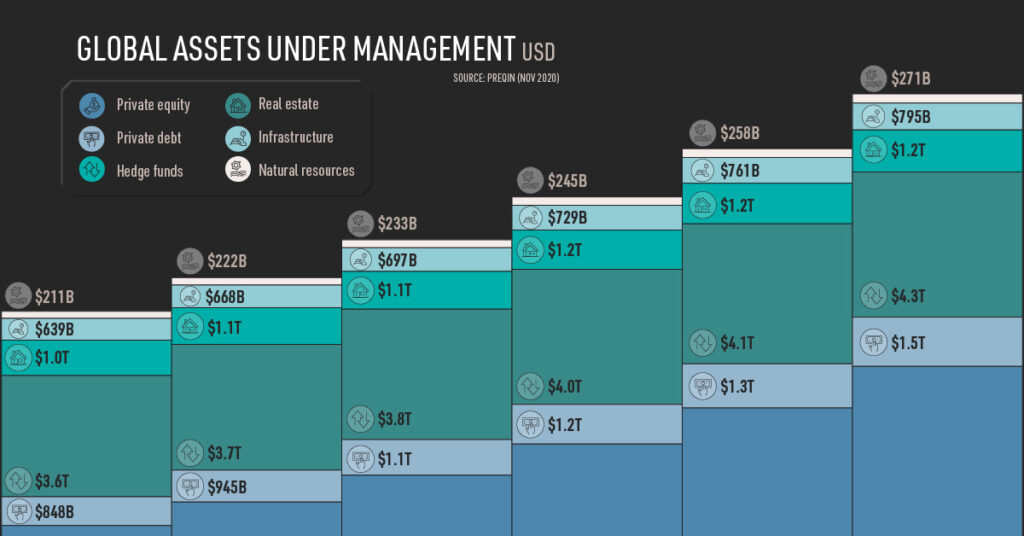
In a prior era of low-interest rates and volatile markets, many investors sought non-traditional assets to generate higher returns. This quest led them to the realm of alternative investments, which is estimated to be a $14 trillion market in 2023. And with non-bank financing institutions filling the banking void, alternative asset managers have become flush with capital pursuing new opportunity.
This guide delves into the world of alternative assets, their various types—including private debt—and the role of asset management.
Contents
Understanding Alternative Investments
Alternative assets refer to investment options that fall outside the conventional categories of stocks, bonds, and cash. They often have a low correlation with traditional asset classes, offering the potential for diversification and risk mitigation. Many of them offer dynamic income opportunities, as there can be recurrent, consistent cash flow from these investments. For those reasons, alternatives have become a staple in portfolios. Historically, alternative assets were a minor part of portfolio managers overall diversification strategy. But as banks and private equity peel back investments, this sector is rapidly growing.
Asset Classes of Alternative Investments
Alternative assets come in a multitude of forms. Some of the most popular types include:
- Real Estate: This includes commercial properties, residential buildings, and real estate investment trusts (REITs).
- Hedge Funds: These are pooled investment vehicles that aim to generate high returns using a range of strategies and asset types.
- Private Equity: This involves direct investment in private companies.
- Commodities: Examples include gold, oil, agricultural products, and other tangible resources.
- Private Debt: Private debt is a type of private credit, typically in the form of loans made to private companies. This category can further be subdivided into merchant notes, corporate payables, and direct lending.
A Deeper Dive into Private Debt Assets
As a subset of alternative assets, private debt has gained considerable traction among investors. Its primary forms include:
- Merchant Notes: These are short-term loans extended to businesses, often backed by the business’s future sales or accounts receivable. They provide companies with immediate access to capital.
- Corporate Payables: Corporate payables represent obligations owed by a company to its suppliers or service providers. By investing in these, investors essentially finance a company’s operations while gaining a return on their investment.
- Direct Lending: In this scenario, investors lend directly to businesses. Direct lending is usually characterized by tailored agreements between lenders and borrowers, bypassing traditional banking intermediaries.
On the whole, private debt (or private credit) can be classified as an asset class because it fits two main criterion to qualify as an asset: private debts offer above cash returns, in compensation for a risk that cannot be eliminated.
When it comes to private debt, the risk unique to debt – the risk of default – will always be there. No matter how much you diversify in private debt, you can’t eliminate this risk. Therefore, because of the above cash returns, private debt (or private credit) can reasonably be classified as an asset class, despite conventional classifications.
The Role of Alternative Asset Management
Navigating the complexities of such an asset class requires a specialized approach, giving rise to the field of alternative asset management.
Understanding Portfolio Management
Alternative asset management involves managing investments in alternative assets. It requires an in-depth understanding of these assets, their risk profiles, potential returns, and how they fit within a broader investment strategy.
Alternative asset managers often manage portfolios that include a variety of alternative assets, ensuring these investments align with the investor’s goals, risk tolerance, and investment horizon. They also conduct extensive research and due diligence to identify the most promising investment opportunities.
Diversification is also a pivotal part of investment management. Without the ability to diversify away the idiosyncratic risk of each deal, you must diversify. So that if one of your alternative investments fails to perform, you can maintain enough cash flow to reinvest.
The Appeal and Risks of Alternative Investments
Investing in alternative assets can be rewarding, but it’s essential to understand the potential risks involved.
The Appeal of Non-Traditional Assets
Alternative assets offer several key advantages. They provide potential diversification benefits due to their low correlation with traditional assets. Additionally, some alternative assets, such as private debt, can generate higher returns, providing a potential hedge against inflation.
The Risks of This Realm of Investment
However, investing in anything also carries unique, idiosyncratic risks. They common one is the lack liquidity of traditional assets, meaning they cannot be readily converted to cash. They may also be more susceptible to market volatility and often require a higher initial investment. Transparency is another issue. Because private debt (or assets in general) are not publicly listed, disclosure requirements are few and far between.
It’s really up to the portfolio manager to try to achieve leverage over the issuer in order to obtain the necessary data to make an informed decision. As one can imagine, that is easier said than done, however, that is part of the reason for higher returns. Off market deals in general yield more than public assets like stocks or bonds.
The Power of This Broad Asset Class
Alternative assets represent a vast and varied world of investment opportunities beyond traditional stocks and bonds. From real estate to hedge funds, private equity to private debt, these assets offer unique advantages for diversification and potential returns.
Engaging with an alternative asset management can provide investors with the expertise needed to navigate these complex markets, as well as earning well-above cash yields on their investment.




